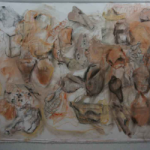
ArtScience Academy of Science

Marks Making No 1 to No 8.

ArtScience Academy of Science

Marks Making No 1 to No 8.
Fractal Lights
Assoc. Prof. Dr. Shureen Faris Abdul Shukor
Mr. Iskandar Khalifah Mohd Razali

Fractals are unique and complicated mathematical forms of art. Patterns repeated at different scales like the branches in lungs and neurons, are fractals where simple mathematical rules apply to a vast array of things that looked visually complex or chaotic. Interestingly, different fractals found in nature when viewed as an enlarged image, some will bore uncanny similarities. Natural fractals such as the surface of water, the structure found in spongy bone, the coral design or aerial view of mountain ridges could give different interpretations from one person to another. For example, at a close angle, the brain cortex somehow could be mistaken as the leaf veins. As been proven from past research, participants recovered from stress 60 per cent better when viewing images with fractal dimension.
Our visual system is in some way hardwired to understand fractals. The stress-reduction is triggered by a physiological resonance that occurs when the fractal structure of the eye matches that of the fractal image being viewed. This Fractal Light project hypothesized that by viewing fractal patterns projected from lights will create an ambiance that could reduce the depression and anxiety level among patients diagnosed with mental health disorders. This project also intends to support mental health services such as the community-based specialist where it demonstrates how patterns of nature can be experienced visually as part of a restorative approach by using lights.
This experimental study on fractals uses light to emphasize the different shape of fractal patterns. Images produced when lights passed through the patterns are varied, including a few that are mysterious or perplexing. The shadows are intended to portray the unification of nature where different fractals seemed interconnected. The project also demonstrates how patterns of nature can be experienced visually as part of a restorative approach by using lights, while the intricacy of the images will evoke curiosity and excitement among viewers. The images of certain fractal geometries found in nature may contribute in the study area of mental stress reduction and eventually how these patterns can be applied in the design around us.The artifact also demonstrates how patterns of nature can be experienced visually as part of a restorative approach by using lights, while the intricacy of the images will evoke curiosity and excitement among viewers.
In this circumstance, the individuality of a person is quantified and broken into divisible digits. Crucially with the ascendency of predictive analytics, algorithms and other data centric intelligence – the affective qualities of a person, or to put it differently the views, thoughts and feeling of an embodied human subject that makes up humanistic subjective reality recedes into some form of subset that could be enumerated. As a result, a subject is ultimately deprived of subjectivity when altered into numeric abstraction of quantifiable data which holds capital value under the pretext of the symbolic authority of scientific objectivism. It is at this juncture that the project argues for the necessity of convergence between artistic and scientific philosophy. Before proceeding, it must be clarified that convergence here must not be taken on face value as an act of coming together or merging of two different philosophical thoughts to demonstrate some form of unification, or cohesiveness in articulation. The hesitation here is driven by the normality of this approach where it usually ends up withholding one domain as mere illustration, or depiction tool for an idea presented by the other – usually being the art as visually interpreting a complex idea put forth by science.



